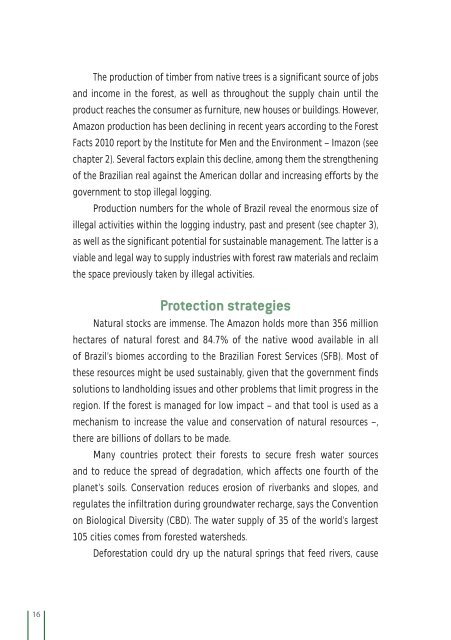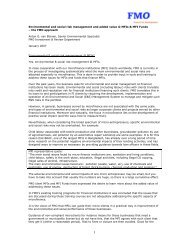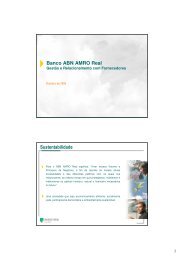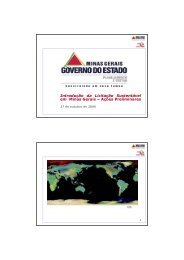From the forest to the consumer - GVces - Fundação Getulio Vargas
From the forest to the consumer - GVces - Fundação Getulio Vargas
From the forest to the consumer - GVces - Fundação Getulio Vargas
Create successful ePaper yourself
Turn your PDF publications into a flip-book with our unique Google optimized e-Paper software.
16<br />
The production of timber from native trees is a significant source of jobs<br />
and income in <strong>the</strong> <strong>forest</strong>, as well as throughout <strong>the</strong> supply chain until <strong>the</strong><br />
product reaches <strong>the</strong> <strong>consumer</strong> as furniture, new houses or buildings. However,<br />
Amazon production has been declining in recent years according <strong>to</strong> <strong>the</strong> Forest<br />
Facts 2010 report by <strong>the</strong> Institute for Men and <strong>the</strong> Environment – Imazon (see<br />
chapter 2). Several fac<strong>to</strong>rs explain this decline, among <strong>the</strong>m <strong>the</strong> streng<strong>the</strong>ning<br />
of <strong>the</strong> Brazilian real against <strong>the</strong> American dollar and increasing efforts by <strong>the</strong><br />
government <strong>to</strong> s<strong>to</strong>p illegal logging.<br />
Production numbers for <strong>the</strong> whole of Brazil reveal <strong>the</strong> enormous size of<br />
illegal activities within <strong>the</strong> logging industry, past and present (see chapter 3),<br />
as well as <strong>the</strong> significant potential for sustainable management. The latter is a<br />
viable and legal way <strong>to</strong> supply industries with <strong>forest</strong> raw materials and reclaim<br />
<strong>the</strong> space previously taken by illegal activities.<br />
Protection strategies<br />
Natural s<strong>to</strong>cks are immense. The Amazon holds more than 356 million<br />
hectares of natural <strong>forest</strong> and 84.7% of <strong>the</strong> native wood available in all<br />
of Brazil’s biomes according <strong>to</strong> <strong>the</strong> Brazilian Forest Services (SFB). Most of<br />
<strong>the</strong>se resources might be used sustainably, given that <strong>the</strong> government finds<br />
solutions <strong>to</strong> landholding issues and o<strong>the</strong>r problems that limit progress in <strong>the</strong><br />
region. If <strong>the</strong> <strong>forest</strong> is managed for low impact – and that <strong>to</strong>ol is used as a<br />
mechanism <strong>to</strong> increase <strong>the</strong> value and conservation of natural resources –,<br />
<strong>the</strong>re are billions of dollars <strong>to</strong> be made.<br />
Many countries protect <strong>the</strong>ir <strong>forest</strong>s <strong>to</strong> secure fresh water sources<br />
and <strong>to</strong> reduce <strong>the</strong> spread of degradation, which affects one fourth of <strong>the</strong><br />
planet’s soils. Conservation reduces erosion of riverbanks and slopes, and<br />
regulates <strong>the</strong> infiltration during groundwater recharge, says <strong>the</strong> Convention<br />
on Biological Diversity (CBD). The water supply of 35 of <strong>the</strong> world’s largest<br />
105 cities comes from <strong>forest</strong>ed watersheds.<br />
De<strong>forest</strong>ation could dry up <strong>the</strong> natural springs that feed rivers, cause








